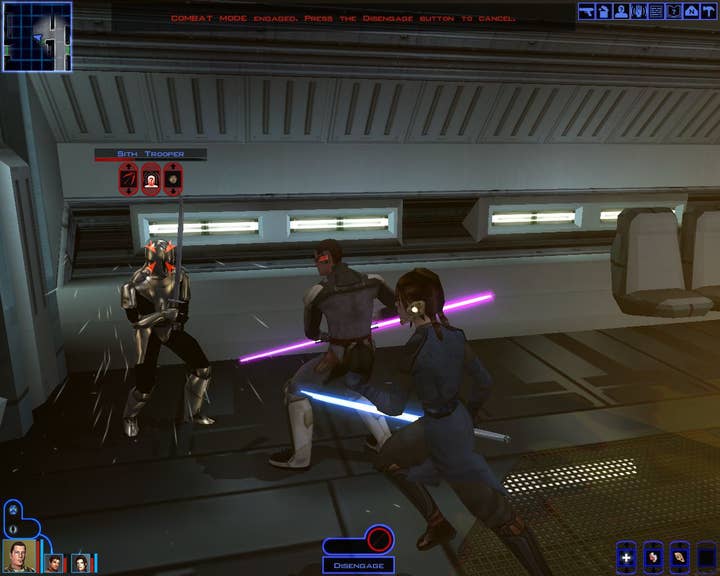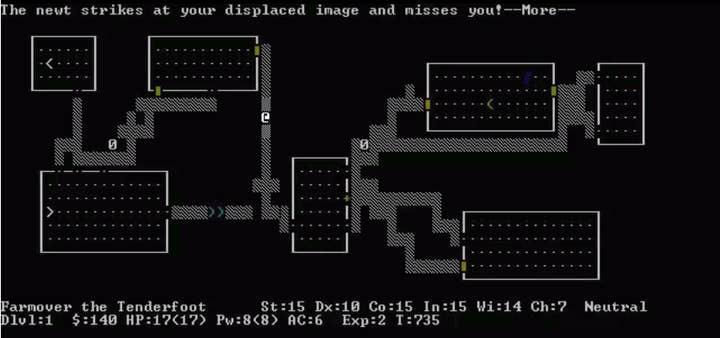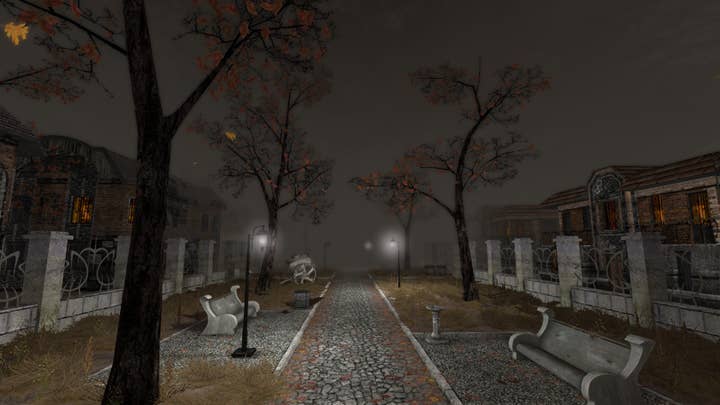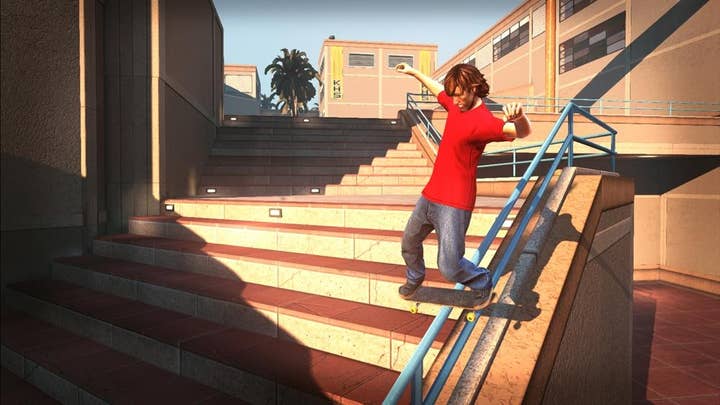Location, locomotion, morality, and imagination
Why I Love: Skydance devs describe what they took from Star Wars: Knights of the Old Republic, Pathologic, NetHack, and Tony Hawk's Pro Skater
Why I Love is a series of guest editorials on GamesIndustry.biz intended to showcase the ways in which game developers appreciate each other's work. Development is typically a team effort, so from time to time, these columns will reflect that. Some of the Skydance Interactive team recently took a break from their work on Archangel and The Walking Dead VR to provide Why I Love write-ups for some of their favorite games, but the result was simply too much to cram into a single column. Rather than edit any of the write-ups for length, we split them between two columns, the first of which we ran two weeks ago.
Star Wars: Knights of the Old Republic
Benjamin Fuhrmann - Game Designer

It's fair to say my concept of video games was limited when I was a child. I didn't have a home console, didn't have a local arcade to frequent, didn't have a DS to play Pokemon with my friends. What I did have was an older brother, one who had a PC with a select few games. My interests were myopic at the time, and they both started with 'S'. Star Wars and Spider-Man were the only things I wanted from games, new ways to experience the characters and worlds therein, new media to sate my ravenous appetite.
Star Wars: Knights of the Old Republic didn't quite fill that gap the first time I watched my brother play it. The game took an alienating path in its setting. Taking place thousands of years before the movies meant the Star Wars iconography familiar to me was largely absent. What was left was a world that dealt in the themes and lore of the movies, while revealing a story that was all its own.
Once I began playing the game for myself I soon learned that there had never been a more open window into the world of Star Wars. The locales were vibrant and varied, the enemies were fierce, and the companions were compelling. There was nothing missing from the experience. It really felt like the first time I could go anywhere and do anything in Star Wars.
Beyond the turn-based combat and Force powers, most central to the experience was the way the game handled its morality. A good/evil slider may seem quaint by today's standards, but in 2004, contextualized by the Dark and Light Side dichotomy of the Force, it felt right at home in this game. Most interesting was the way in which Dark Side Force powers truly made conflict easier, especially in the late game. There was a consonance of message between the Dark Side's nature in the movies and in Knights of the Old Republic. The Dark Side wasn't just about sadism or blind evil; it was the easy way out when contrasted with the Light Side's discipline.
At a young age, Knights of the Old Republic gave me a safe, understandable, and fun way to play this concept out in my favorite universe. My companions demonstrated the consequences of my choices by rejecting my path, mirroring my morality, or becoming inspired by my leadership. Every moment of play was given weight; every snippet meant so much to me. All these memories culminated in an experience that I will carry with me for the rest of my life.
NetHack
Mark F. Domowicz - Creative Director

I remember distinctly how I felt when I played Super Mario Bros. back in 1985. To me the Mushroom Kingdom was alive. It existed. I didn't see sprites on screen, as much as I saw hints of the much deeper modern-day Alice In Wonderland that it was. I imagined and I participated. I filled in the blanks that the limited technology of the day left for me. Much as how the big-screen boogeyman is scariest when you don't see him, The Mushroom Kingdom, and Zebes, and Hyrule, and so many of the video game worlds of that era, were the most real to me in their least articulated forms.
I was young then. The way I experienced video games was different from the way I experience them today. Partly because I'm an adult, and mostly because I'm a game developer, playing a video game now is some parts analysis, some parts appreciation, some parts criticism, even some parts envy. It's almost no part escapism or immersion or wonder. It's not that I enjoy games less. I just enjoy them differently.
But is that it really? NetHack was the first game in my adult, game-industry professional, life, that made me ask, "Am I too old to imagine? Or are modern games too preoccupied with fidelity to let me?" When I played NetHack for the first time, I was immersed in its universe to a degree that I'd not felt since I was a kid. Because the only "graphics" in NetHack are alphanumeric symbols, it was my own imagination doing the hard work. And because the mechanics are axiomatic and intermingling, the narrative wrote itself, just in time, before my eyes. It was the closest computer approximation to playing live Dungeons & Dragons that I'd ever seen before or since. It was, and remains, to my mind, the video game equivalent of reading a good book.
My love for NetHack has reached deep into the entirety of the "roguelike" genre from which it was borne and which it helps define. Roguelike features direct my interest in games to play, and roguelike ideas color my design sensibilities. My last title, Archangel, even has a "permadeath" mode - one of the most defining features of the genre.
But as my appreciation for the genre ever grows, and as the beauty and infinite depth of the best roguelikes continue to inspire me, it remains that I love NetHack the most. It was NetHack that brought me back to my childhood and gave me something back that I had lost long ago. It was NetHack that reminded me why I fell in love with video games at all.
Pathologic
Pablo Leon-Luna - Programmer

I first heard of Pathologic when my friend Mykolas played it back in 2006. He complained that the game was broken, extraordinarily difficult, and bleak. Yet, he still wanted to beat it. Almost a decade later, I rediscovered Pathologic and it became my main source of inspiration as a game developer.
Pathologic has a narrative, but rather than being a linear path of events, it is a small open world where nothing feels forced but everything feels necessary. During my first play experience I thought to myself, "How did the developers manage to put this together?" I could not fathom the systems at work in the game's narrative progression. In games, there is usually a clear path cut out for you, and you experience the narrative through events that play out like a script. Even "open world" games like GTA have story modes that are basically linear. Pathologic, however, transcends the forced linear story mode model in a way that is subtle and still somewhat incomprehensible to me.
In Pathologic, you absorb the narrative through a combination of NPC interactions, time-based occurrences, and resource management. Rather than focusing on an individual human, Pathologic sets the main character as The Town. The Town is the being with whom you interact, with whom you develop a relationship. This allows the developers to think of the player as an agent in a town whose story will happen anyway. The Town will evolve and change over the course of 12 in-game days, and the player has the freedom to be there and witness the change, and perhaps affect it.
This is what gives Pathologic that sort of existential dread: It is a deeply impersonal game. The story does not really care if you are there or not. But if you want to take part, you have to play by its rules. What you discover after you play the game is not so much the story of one person, but the history of a small city and its doomed inhabitants. It takes the focus off of the self and places it on a societal scale. In this way, it affords itself room to deviate from the linear structure often found in video game storytelling.
Pathologic deserves more attention that it received, it was far ahead of its time. 13 years after the original game's release in 2005, Russian developer Ice Pick Lodge will be releasing a remake with additional features called Pathologic 2. It is a must-play for anyone remotely interested in narrative game design.
Tony Hawk's Pro Skater
Nathan Ednave - Game Designer

Whenever I come up with a game concept, movement is always on my mind. How do I make locomotion feel good when all you're doing is wiggling an analog stick around? How do I make movement feel responsive? How can I make it fun? There are plenty of mechanics that get frequent revisions, but innovating on movement seems to be on the back burner. When someone does actually come up with a unique movement scheme, it gets people's attention. Games like Katamari Damacy, Snake Pass, and QWOP are all known for their innovative locomotion, but none are as influential as one game series that helped spawn a whole new genre of extreme sports games: Tony Hawk's Pro Skater.
The Tony Hawk's Pro Skater series paved the way for an explosion of extreme sports titles, as other studios soon followed its innovative movement and trick system. What makes Tony Hawk games so near and dear to my heart is that they encourage the player to be in constant movement and to be as stylish as they can. Locomotion and style are embedded into its objectives, the trick system, and especially the level design. The timer pressures the player to keep moving. The trick system encourages players to combo as many tricks as they can. Players can keep a constant flow of movement throughout the levels; dead ends don't exist.
What really solidifies my love for the Tony Hawk games is that they include a free skate mode. This mode just allows the player to move around the level. Video games are often defined with end goals and challenges; they give players a purpose in playing a game. Free Skate is a playground without predefined goals or challenges, but it still ends up being my most beloved mode because you get alone time with the game's movement.
Game mechanics are constantly evolving to make the end goal more exciting, but it's a whole other thing if you can make a game where a player can waste hours upon hours just being in motion.
Upcoming Why I Love columns:
- Tuesday, April 24 - Quantum Soup's Chris Payne on The Sentinel
- Tuesday, May 8 - Solar Sail's Tancred Dyke-Wells on Tenchu: Stealth Assassins
- Tuesday, May 22 - Sperasoft's Steven Thornton on Portal 2
Developers interested in contributing their own Why I Love column are encouraged to reach out to us at news@gamesindustry.biz.